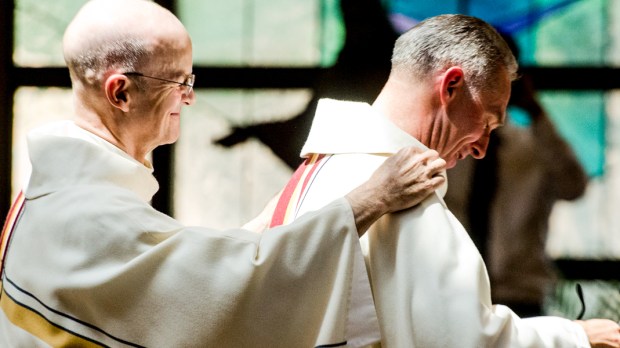Sometimes going to Mass can be confusing for a Catholic unfamiliar with deacons. Both clergy members wear vestments at Mass and in some dioceses, both even wear Roman collars. To make it even more confusing, sometimes priests and deacons wear the same gray-colored clerical shirts with those Roman collars.
However, while deacons and priests may sometimes appear to be the same, their roles in the Church are very different.
The USCCB provides a succinct definition of a deacon and his particular role in the Church.
“A deacon is an ordained minister of the Catholic Church. There are three groups, or ‘orders,’ of ordained ministers in the Church: bishops, presbyters and deacons. Deacons are ordained as a sacramental sign to the Church and to the world of Christ, who came ‘to serve and not to be served.’ The entire Church is called by Christ to serve, and the deacon, in virtue of his sacramental ordination and through his various ministries, is to be a servant in a servant-Church.”
Deacons have been around the Church since the very beginning, frequently being referenced in the New Testament. To clarify this history Pope Francis created a commission to investigate the role of deacons in the early Church, looking especially at the role of women deacons.
The most well-known reference to deacons in the New Testament is from the Acts of the Apostles. It reads, “And the twelve summoned the body of the disciples and said, ‘It is not right that we should give up preaching the word of God to serve tables. Therefore, brethren, pick out from among you seven men of good repute, full of the Spirit and of wisdom, whom we may appoint to this duty'” (Acts 6:2-3).
From the very beginning deacons were known to serve and assist the priests and bishops in their sacramental ministry.
Practically speaking deacons can do many activities that priests participate in. Deacons can baptize, preach during Mass, officiate at a Catholic wedding, and even run a parish (with the permission of the local bishop). Deacons can also lead communion services that often look and feel like a Catholic Mass.
Deacons, however, can not consecrate the Eucharist or hear confessions. They can not administer the sacraments of Confirmation or Anointing of the Sick.
Simply put, deacons are meant to be servants, assisting the pastor (and Church) in whatever way he can.
All priests and bishops are also deacons, because the diaconate is the first of the three stages of Holy Orders. Deacons who go on to be ordained priests are known as transitional deacons. They are vowed to celibacy. Men who serve in the permanent diaconate — meaning they will not, as a rule, proceed to priestly ordination — may be married at the time of their ordination, but may not remarry if their spouse passes away.
The permanent diaconate is a specific vocation in the Church, one that depends on the inspiration of the Holy Spirit. God is the one who calls deacons to service in the Church through the sacrament of Holy Orders. It is important to remember that it is not something that is gained by going through the ranks of the Church, but something that is given (and received) through the grace of God.

Read more:
What is a parish?

